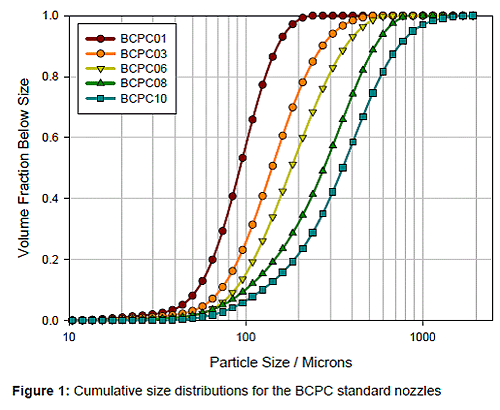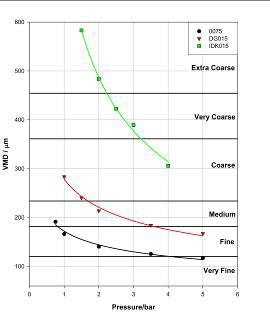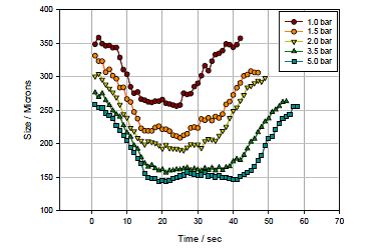Pesticides play a major role in ensuring secure levels of food production worldwide. Their continued use appears essential given the prospect of a burgeoning global population, alongside other pressures on land. However, the impacts of herbicide, fungicide and insecticide use on human health and the environment remain a major cause for concern.
In January 2009, the European Parliament approved pesticide legislation that reflects an increasing awareness of the need to tighten controls. The legislation bans the use of some hazardous chemicals and introduces measures to reduce risks. The new laws highlight the need for continued research into new, compliant formulations and the importance of improving the application of existing products in order to minimize off-target contamination.
The droplet size of pesticide sprays is a critical parameter, affecting environmental and economic issues such as spray drift, efficiency and wastage. At the point of delivery, droplet size and other spray plume parameters are controlled primarily by the nozzle itself. Consequently, choosing the correct nozzle is vitally important. This article describes the use of laser diffraction technology (Spraytec, Malvern Instruments) to measure agrochemical droplet size, and discusses how this supports the informed selection of appropriate nozzles for pesticide application, based on targeting requirements and spraying conditions.
Delivered droplet size is one of the most important controllable parameters in pesticide application. Effective size control ensures maximum product efficacy and cost efficiency, and reduces damage to off-target sites. Determining an appropriate droplet size for a given application demands careful consideration of the pesticide delivery mechanism, and the potential for adverse impact.
In many circumstances, fine sprays are associated with optimum efficacy, and it has been shown that the highest levels of spray deposition on small plants occurs with the finest sprays. However, larger droplets are less likely to be deflected by air flows and therefore create less off-target contamination. Pesticide users frequently have to balance the needs of optimizing efficacy with the requirement to control drift and therefore have to select a droplet size that is as large as considerations of product efficacy will allow [1].
Spray drift is the movement of agricultural spray into any area other than the intended target and can be particularly hazardous near sensitive high-value crops, in residential districts or close to watercourses. Preventing spray drift is one of the most challenging problems for pesticide manufacturers and users.
The main factors influencing spray drift are [2]:
Of these, droplet size is the most influential factor that is also easy to control. The settling velocity of a particle is proportional to the square of the particle diameter, so smaller particles are more likely than larger ones to drift away from the target before settling. Controlling the droplet size addresses the problem and also increases the range of weather conditions under which it is safe to use a given pesticide, allowing better timing of pesticide application.
Establishing the optimum droplet size and selecting an appropriate system for agrochemical application depends on two key factors: successful characterization of the spray plume and correlation of the droplet size data with behavior in the field, under realistic application conditions. A variety of protocols and techniques are used to achieve this, including laser diffraction analysis for droplet sizing and wind tunnel trials to assess the impact of environmental conditions on the application process.
While different droplet sizing techniques have been used to characterize agrochemical sprays, the flexibility and speed of laser diffraction makes it arguably the most effective and productive. Laser diffraction systems calculate size by measuring the intensity of light scattered by the droplets as they pass through a laser beam. The angle at which light is scattered is inversely proportional to droplet size. Spray size distributions are calculated by measuring the changes in scattering intensity as a function of angle, and applying an appropriate scattering model to the acquired data.
Some laser diffraction systems are specifically designed for spray characterization, the Spraytec (Malvern Instruments) being a prime example. High data acquisition rates permit the detailed study of atomization dynamics, and determination of average delivered droplet size. Measurements can be made while the spray passes through the measurement zone, allowing the investigation of spray plume geometry and concentration variations. The resulting information is highly valuable in determining system performance, and in particular for detailed nozzle classification, as illustrated by the study below.
Wind tunnel trials are used to correlate system performance and droplet size data with application control issues such as spray drift and take-up. The Arable Group (TAG) Spray Application Unit at Silsoe (Bedfordshire, UK) houses an advanced wind tunnel for the replication and control of field conditions such as humidity, wind speed and crop/surface condition. Trials here enable the development of sophisticated models, which are used to assess risk and advise farmers and growers on pesticide use.
Several components of agrochemical spraying systems can be adjusted to produce droplets that meet established size requirements for spray control and effective delivery. Spray pressure, boom height, pesticide volume and spraying angle can all be manipulated. However, because of the dominating influence of nozzle geometry on droplet size distribution, nozzle or atomizer selection is a critical factor. A wide variety of nozzles are available, producing plumes of different shapes with variously sized droplets.
Given the importance of spray nozzles in determining droplet size, and the consequent impact on pesticide efficiency and potential side effects, the British Crop Protection Council (BCPC) has developed a spray classification scheme [3]. This is intended to help in selecting the most appropriate spray size and distribution for specific products. To this end, the BCPC scheme classifies agricultural nozzles into six droplet size categories (Very Fine, Fine, Medium, Coarse, Very Coarse and Extra Coarse). These nozzles can then be selected for use, based on the target and the risk of spray drift.
Five standard British Crop Protection Council (BCPC) nozzles (BCPC01, BCPC03, BCPC06, BCPC08 and BCPC10) at the boundaries of different classes were characterized using the Spraytec system. The resulting measurements define the classification grid in terms of volume median diameter values (Dv50), the droplet size below which 50% of the population lies. This grid was used to assign a classification to other non-standard nozzles, operated at various conditions.
Each spray was analyzed as it traversed the instrument's measurement zone, allowing droplet size to be determined as a function of position within the plume. The cumulative volume-based characteristic size distribution for the entire spray plume was then calculated by averaging all the data obtained during the traverse, weighted according to the concentration of the spray at each measurement point.
Cumulative size distributions for the standard BCPC boundary nozzles are shown in Figure 1. The data confirm that measured particle size increases for nozzles with higher classification numbers, as expected.

|

|
Three flat-fan nozzles (0075, DG015 and IDK015) were analyzed in an exactly analogous way. Particle size distributions were measured for a range of liquid pressures between 0.75 and 5 bar. Figure 2 shows the Dv50 values for each nozzle as a function of the operating pressure plotted on the defined classification grid.
The Dv50 data for Nozzle 0075, is shown to vary from 191 μm at 0.75 bar, to 117 μm at 5 bar indicating that it fits the 'Fine' classification at operating pressures of between 1 and 4 bar. While such a spray might be expected to give good levels of pest control, the implications for spray drift would probably rule out its use under most field conditions.
The Dv50 for nozzle DG015 varies from 283 μm at 1 bar, to 167 μm at 5 bar. Therefore, in the range 1.5 to 3.5 bar, this nozzle produces a medium spray that would, for example, be ideal for the treatment of broadleaf weeds. The third nozzle, IDK015, generates a droplet size that varies between 583 μm at 1.5 bar, and 306 μm at 4 bar. Under BCPC classification, these droplets would be defined as either very or extra coarse, depending on pressure. Such a nozzle would be expected to give a very low risk of drift, but the pesticides for which it would give acceptable efficacy would be limited.
The data obtained for these three flat nozzles illustrate how droplet size information can be used to classify nozzle designs and provide guidance for selecting both nozzle and operating pressure for a specific crop in a specific location. These data enable fine-tuning of droplet size in order to increase take-up by the crop, ensure that operational and weather conditions are well matched at the time of spraying, and minimize any undesirable environmental impact.
As well as measuring average particle size, laser diffraction is used to study droplet size variation across the spray plume. Such data are particularly useful in optimizing nozzle design.
Operating in continuous rather than 'rapid' mode, the Spraytec records particle size distribution once per second, for up to an hour, monitoring changes in droplet size over time, as a spray traverses the measurement zone. Particle size histories for nozzle DG015 were measured for spray traverses at a series of different pressures. Results (figure 3) show that each traverse of the plume has a characteristic shape, with larger droplets at the edges of the plume and smaller droplets at the center.

|
Figure 3 demonstrates that an increase in pressure reduces average droplet size from the nozzle. However, this is not the only effect of pressure on the spray plume: the duration of the particle size measurement increases as the liquid pressure is increased. Since each traverse was carried out at the same speed, this suggests that the width of the spray plume increases at higher pressures. The pressure at which the nozzle is operated affects both droplet size and plume angle.
The increase in plume angle with pressure may be significant when setting boom height to ensure a consistent spray at the target level. Ideally, to minimize spray drift the boom should be operated as close to the sprayed surface as possible. Reducing pressure in order to increase droplet size and thereby reduce drift is relatively common practice, but the consequence may be a reduced plume angle and therefore an inadequate spray pattern which could result in stripes of under-dosed crop.
New European legislation on pesticide use and control is intensifying the need for reliable analytical techniques. For pesticide application systems, delivered droplet size is a key parameter, because it influences the efficiency of delivery of the active ingredient and the probability of adverse environmental impact. Optimizing droplet size enables targeted spraying and efficient application, simultaneously reducing the possibility of hazardous exposure and providing both economic and environmental benefits.
Laser diffraction is a powerful method for measuring both the droplet size of pesticide sprays and plume angle, also an important variable especially for setting boom height. Here a Malvern Spraytec laser diffraction system was used to characterize nozzle performance. Nozzle choice is one of the easiest ways for a grower to influence droplet size, so selection is an important issue. In this study, standard nozzles defining the BCPC size categories were measured. Three additional nozzles were then analyzed at a range of pressures, and classified according to the defined grid in terms of their suitability for different applications. Particle size histories measured at different pressures showed that increasing pressure causes a widening of the spray plume. The results confirm that laser diffraction droplet size analysis delivers valuable and useful information for developing new agrochemical equipment and pesticide formulations.
Experiments described here were made possible through the invaluable assistance and expert advice of Clive Tuck and Paul Miller at The Arable Group's spray applications unit, the UK's leading independent crop research and consultancy organization.
[1] Home Grown Cereals Authority (2007) Nozzle Selection Chart www.hgca.com
[2] Using Pesticides, Reducing Spray Drift http://www.pesticides.gov.uk/safe_use.asp?id=61
[3] Doble S J, Matthews G A, Rutherford I, Southcombe E S E (1985). A System for Classifying Hydraulic and Other Atomizers Into Categories of Spray Quality. Proceedings British Crop Protection Conference - Weeds, 3, 1125-1133. [4] ISO 10625:2005.